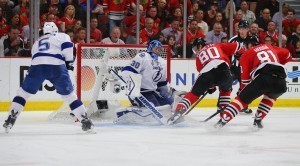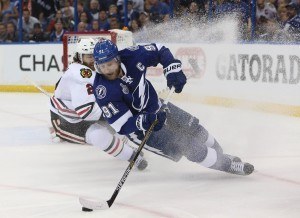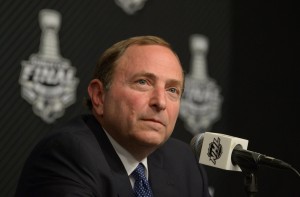The 2015 Stanley Cup playoffs has had its share of interesting and emotional moments. Rising talents coming to the forefront, elimination and heartache, and jaw-dropping displays of grit and athleticism.
While the majority of the action on the ice has been exciting, there have been a number of polarizing topics away from the ice. With no shortage on water cooler hockey talk, THW presents “Five NHL Hot Takes”.

1. The Lady Byng Cup Finals?
The desire to win has been there. The effort has been there, specifically in the form of shot blocking. But it doesn’t seem like, and maybe it’s just me, that the hate and animosity has been there.
There doesn’t seem to be the feeling that these two teams have any true disdain towards each other.
Obviously they want to win. Clearly their doing everything in their power to win.
But at no point of this Cup Finals has it felt like a fight is about to break out. That’s not to suggest a fight has to happen for there to be animosity, but there’s just no element of hatred between Chicago and Tampa Bay.
The series has been defensive and fairly disciplined. Both coaches have emphasized that, and when you look at the penalty minutes totals after the first four games of the series, it’s evident that neither team wants to be penalized for an undisciplined, stupid mistake.
|
Game 1 |
Game 2 | Game 3 | Game 4 | TOTAL PIM | |
| PIM | 10 | 12 | 12 | 14 |
48 |
In total, 24 minor penalties were called in the first four games of the Cup Finals. Less than half of those infractions were for penalties that can be described as “physically excessive” or “violent” in nature (such as slashing, cross-checking, or high-sticking).
So while there are penalties being called, the majority for interference or holding, the intent of the play which drew a penalty isn’t to obliterate the opposition player, but rather to slow them down.
The emphasis is on the defensive aspect. It’s about not getting beat and allowing the other player to generate a scoring chance.
The hatred and animosity between Tampa Bay and Chicago could still develop, but seeing as how every game has been so tightly contested and how neither team wants to take an egregious and undisciplined penalty, it doesn’t seem likely we’ll be witnessing many heated moments.

2. Playoff Beards and NBC
When the commentary from NBC’s Mark Lazarus broke, my initial reaction to the notion NHL players should shave their playoff beards to become more marketable, was one similar to most hardcore fans.
Shut up and let the beards be. It’s tradition. It’s uniquely hockey. It’s awesome.
But then I started to think about it more.
While I don’t necessarily agree with the idea, there is merit to the suggestion. Because if the NHL can gain even one more fan, and if the NHLPA can profit just a single dollar more, then the beards could go.
For instance, if a major razor company were to come in with a substantial endorsement deal for NHL players to go clean-shaven, players will absolutely forgo the ‘Grizzly Adams’ look to pocket some extra cash. The players would get what they want in more money. NBC and Mark Lazarus would get what they want in a more marketable NHL star.
But maybe this could go the other way. Maybe a big cancer research foundation proposes a deal to the NHL where the players keep their beards, and at the end of the playoffs, they all shave them off in support of cancer research.
Ultimately the comments from Mark Lazarus weren’t directed towards hardcore hockey fans, because regardless of facial hair or not, we’ll still be tuning in to watch the games. But if the NHL has an opportunity to expand its fan base, then Gary Bettman will (at the very least) listen to whatever ideas his biggest partner proposes.
3. Kane and Stamkos Remain Dormant
Maybe the best players just need the stakes to get high before they can elevate their play, but so far through the first four games of the Cup Finals, two of the most electrifying players on the planet have been incredibly underwhelming…at least in terms of point production.
Steven Stamkos and Patrick Kane are incredibly dynamic away from the puck, but their greatest contribution to their respective teams are as pure goal scorers.
Every team wishes they had a Kane or Stamkos, however there is a downside to a player whose main contribution to the team is scoring goals; when said player isn’t scoring goals, there’s not much else he can do to help the team win.
The effort is there, but the production isn’t, and ultimately if the production isn’t there the team suffers.

Steven Stamkos
With 43 goals this season, Steven Stamkos finished second in the NHL goalscoring race.
He’s been a point-a-game player his entire NHL career, amassing 498 points in 492 NHL regular season games.
But through the first four games of the Cup Final, Stamkos has struggled to find the point production that has made him a star.
Here’s a look at how Stamkos produced at various points through this season.
First 24 games of the season: 15 goals, 28 points, +3
Last 24 games of the season: 13 goals, 19 points, +2
Post Season (24 games played): 7 goals, 18 points, +2
Cup Final (4 games played): 0 goals, 1 point, -1
Now it’s not as though he’s had a wretched playoffs. He’s posted 18 points in 24 post-season games so far. But Stamkos has scored just seven goals, and has yet to beat Corey Crawford in the Cup Final.
Stamkos has been all but neutralized through the first four games against Chicago, tallying eleven shots on goal, producing just one assist.
Patrick Kane
Showtime has yet to show up at the Cup Final.
On one hand, it remarkable that Patrick Kane was even able to play at the start of the 2015 NHL Playoffs. Coming back from a painful injury, Kane injected life into a Blackhawks lineup when they needed it most.
But on the other hand, so far in the Cup Final, Patrick Kane hasn’t been able to provide the lift he has so many times before.
In the first four games of the Cup Final, Kane has amassed just one assist and a mere nine shots on goal. In game two of the Cup Final, Kane didn’t even register a shot on goal.
Here’s a glimpse at how Kane produced throughout the year.
First 21 games of the season: 8 goals, 17 points, -2
Last 21 games of the season: 8 goals, 22 points, +2
Post Season (21 games played): 10 goals, 18 points, +2
Cup Final (4 games played): 0 goals, 1 point, -1
While Kane’s point pace in the post-season is actually pretty consistent with his regular season production, his inability to score in the Cup Final is a drastic drop-off.
The eventual Stanley Cup winners could be determined by whichever one of these two superstars break out first.

4. Has John Cooper Out-Coached Joel Quennville?
While some fans might have been anticipating a high-flying, run-and-gun style of play between the Tampa Bay Lightning and the Chicago Blackhawks in the Stanley Cup Finals, three of the four games have been under a total of five goals.
The games have essentially been a coin flip. The play has been defensive-minded, with an emphasis on limiting opposition scoring chances.
While both Jon Cooper and Joel Quennville have been masterful behind the bench in these playoffs, so far in the Cup Finals, it’s the fresh-faced Cooper that has gotten the better of his strategic counterpart. While both teams have had to deal with injury, Jon Cooper has done an incredible job of adapting and implementing strategy to mask the weaknesses in his team, most notably the inexperience of Andrei Vasilevskiy who was pressed into action after starter Ben Bishop suffered an unspecified injury.
Cooper has done a masterful job of limiting Chicago’s ability to generate chances, the Lightning believe in and execute his defensively responsible systems, and he’s been able to instil a sense of confidence and determination in every one of his players.
He’s even been brilliant in managing distraction in the media.
Earlier in the Cup Finals, Jon Cooper called a press conference at the exact time Ben Bishop was on the ice testing his physical abilities. In his press conference Cooper didn’t say anything substantial, and it couldn’t have lasted more than ten minutes.
What Cooper did do was take the attention away from the big distraction, the Ben Bishop injury, by gathering nearly every reporter in the facility into a tiny room where their prying eyes couldn’t scrutinize the every movement of the ailing goaltender.
Be sure to check out Dan Herrejon’s latest piece on the Tampa Bay bench boss, “The Brilliant Strategy of Jon Cooper”.
5. The NHL’s Desire to “Go West”
Recently there have been various reports and lots of chatter about NHL relocation and/or expansion.
While both Bill Daly and Gary Bettman have publicly stated that the NHL isn’t entertaining the notion of relocation right now, they have both also stated the desire to look West before adding another team to the East.
Their explanation is basic; With 16 teams in the Eastern Conference and just 14 teams in the Western Conference, the NHL wants to balance the conferences by going West.

But that’s a lazy explanation, because as hockey fans know, the NHL hasn’t let physical geography dictate conference placement in the past (just ask Detroit Red Wings fans).
There’s nothing wrong with relocating or expanding West, but it doesn’t make sense for the NHL to take a substantial risk in going to a non-traditional hockey market simply because it’s located in the West.
It especially doesn’t make sense if the league is leaving profits on the table. Although they’d never publicly admit it, the NHL knows that they’d have a financial golden ticket if they were to add teams in Quebec City and Toronto.
Take the actual market out of the equation. Let’s look at a relocation scenario as such.
Currently in ‘City X’ the NHL is losing $10-million each year. If the team relocates to ‘City Y’ (similar to ‘City X’ in that it’s a non-traditional hockey market with no real demand of the product or attachment to the game) ‘City Y’ is likely to face the same challenges in selling the product that the team is currently facing in ‘City X’.
But if the team relocates to ‘City Z’ (a place where the game is understood and celebrated, and where the ability to consume NHL hockey isn’t currently being met or is underserved) then the product is far more likely to succeed, because the population of ‘City Z’ is already looking for ways to increase their hockey consumption. While there’s no guarantee its profitable, the risk of losing revenue is far less in ‘City Z’ than it is in ‘City X’ or ‘City Y’.
In ‘City Z’ there is no learning curve for the consumer. There are no problems getting a population to embrace and support the sport, because the sport is part of their culture. It’s not a foreign concept.
The people of ‘City Z’ already want to spend money on the product, unlike the residents of ‘City Y’ who need to be coaxed into buying the product. That’s the difference between relocating/expanding to a place like Las Vegas ahead of Quebec City or Toronto.
If overall revenue and franchise value are the biggest concerns for the business of the NHL, the league could end up devaluing its product by looking to the West before capitalizing on untapped or under-serviced markets in the East.
Sure, relocating a team to Quebec or Toronto would create issues in trying to even out an already unbalanced number of teams in the East and West, but who doesn’t like a good conference realignment…right Red Wings fans?